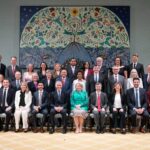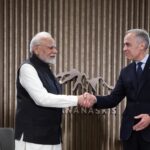Fresh from presenting his first budget, Prime Minister Mark Carney’s Liberal government is taking ambitious strides to project a revitalized image of Canada – both domestically and internationally. With two no-confidence motions defeated in Parliament and a recess underway, the government is moving full throttle on its public outreach at home and aggressive investment-seeking abroad.
This week, Canada hosts foreign ministers from G7 nations – France, Germany, Italy, Japan, the United Kingdom, the United States, and the European Union – along with outreach partners including India, Australia, Brazil, Saudi Arabia, South Korea, Mexico, South Africa, and Ukraine. The meeting at the Niagara-on-the-Lake Conference Centre, spanning over 67,000 square feet, marks the final major event under Canada’s G7 presidency.
For two days, ministers will deliberate on global economic and security challenges – from maritime safety and energy resilience to critical minerals and trade disruptions. Against the picturesque backdrop of Niagara Falls, the gathering symbolizes both natural beauty and diplomatic purpose. Officials hope the tranquil surroundings will foster candid discussions on reducing tariff tensions and restoring global economic stability.
Set amid a region rich in history and natural grandeur, Niagara-on-the-Lake offers visiting dignitaries glimpses of Canada’s heritage and innovation. Once the capital of Upper Canada, the town features 19th-century colonial architecture and landmarks such as Fort George and the Brock Monument, memorials to the War of 1812.
Nearby attractions – from Hornblower Niagara Cruises and Journey Behind the Falls to the Welland Canal and Shaw Festival Theatre – are expected to provide delegates a taste of Canadian culture between meetings. Organizers hope these experiences, along with outdoor options like hiking and cycling trails, will strengthen informal engagement among ministers.
Speaking recently at the Canadian Club in Toronto, Carney warned that “the world has been becoming increasingly dangerous and divided.” He noted that disruptions in global trade and a decade of stagnant business investment have hampered Canada’s productivity, which has grown only 0.3 percent annually — trailing most G7 peers.
“These factors have weighed on wages, job creation, and Canada’s prosperity,” Carney said. “Budget 2025 is for making Canada strong as it confronts these challenges head-on.”
Carney’s first budget outlines a plan to mobilize $1 trillion in total investments over the next five years. The focus, he said, is to harness Canada’s strengths in innovation and human capital to “create more high-paying careers, thriving businesses, and greater certainty for investors.”
According to the government, Budget 2025 represents a “new economic strategy” to supercharge growth through strategic investments in workers, industries, and national infrastructure. Key measures include:
- A productivity super-deduction to make it easier for businesses to invest in Canada.
- Enhanced research and development tax incentives to spur innovation.
- Major Projects Office acceleration to fast-track infrastructure and energy initiatives.
- An International Talent Attraction Strategy to position Canada as a magnet for global expertise.
- Stronger competition and consumer protections to lower costs and drive innovation.
“Budget 2025 is about building Canada strong: investing in our people, our ideas, and our industries,” Carney emphasized. “We’re ushering in a new economic strategy to supercharge growth and give businesses the confidence to invest. We will enable $1 trillion in total investments in five years – to give ourselves more than any country could ever take away.”
At the domestic level, Carney’s ministers have launched a series of regional conferences to explain the budget’s goals and reassure Canadians about the government’s direction. These outreach sessions are aimed at small businesses, investors, and local communities.
While Canada’s economic revitalization is a key priority, its foreign policy efforts under Carney’s leadership are equally assertive. Foreign Affairs Minister Anita Anand, International Trade Minister Maninder Sidhu, and Minister for Economic Development Mélanie Joly have been leading efforts to reinforce Canada’s partnerships and attract international investment.
The Niagara meeting builds on several earlier G7 ministerial gatherings under Canada’s presidency. In March, Canada hosted a Foreign Ministers’ meeting in Charlevoix, Quebec, followed by the Finance Ministers and Central Bank Governors’ meeting in Banff, Alberta in May. The G7 Leaders’ Summit in Kananaskis, Alberta in June – attended by Indian Prime Minister Narendra Modi as a special guest – provided a forum to address global security, economic resilience, and digital transformation.
The current conclave in Niagara, which includes more than a dozen major economies, is expected to reinforce dialogue on trade, supply chains, and sustainable development. Canada hopes the meeting will also encourage Washington to revisit its recent tariffs, which Ottawa argues threaten North American competitiveness.
The G7, established in the 1970s, is an informal grouping of advanced democracies that collaborate on issues such as global economic stability, peace, and transnational security. Canada joined in 1976, and the European Union was invited the following year. The group operates by consensus without a permanent secretariat, and its presidency rotates annually among the seven members.
Canada’s 2025 presidency, its seventh, has focused on economic resilience, digital innovation, and gender equality. Since assuming leadership in January 2025, Canada has worked to strengthen international cooperation through summits, ministerial meetings, and year-round working groups addressing ongoing crises.
Previous Canadian presidencies have produced landmark initiatives. The 2010 Muskoka Initiative pledged over USD $7.3 billion for maternal, newborn, and child health, while the 2018 Charlevoix Declaration on Quality Education mobilized $3.8 billion for women’s and girls’ education worldwide. That same year, the G7 Rapid Response Mechanism was launched to counter foreign threats to democracy, and the Gender Equality Advisory Council (GEAC) was established to promote gender parity across the G7 agenda.
The GEAC, created by Canada, continues to shape global policy dialogue. Its annual reports have advanced recommendations on women’s leadership, gender-based violence prevention, education, and care work. In 2022, it inspired the launch of the G7 Dashboard for Gender Gaps, now a key benchmark for measuring progress on equality among member states.
As the Niagara summit unfolds, diplomats will be balancing discussions on economic resilience, supply chain diversification, and sustainable development against the broader backdrop of geopolitical tensions. The presence of outreach partners such as India, Brazil, and South Africa highlights the G7’s growing recognition of the Global South’s role in shaping future trade and governance structures.
Carney’s government hopes to leverage this moment to reaffirm Canada’s global leadership –bridging its economic agenda at home with its diplomatic mission abroad. Officials emphasize that collaboration on climate action, technology, and inclusive growth will define the legacy of Canada’s G7 presidency.






